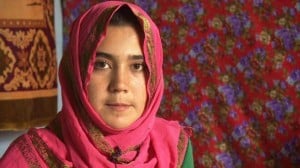Named from an Afghan saying that “However tall the mountain, there’s always a road,” However Tall the Mountain: A Dream, Eight Girls, & A Journey Home is the true story of a project conceived by the book’s author, Awista Ayub, to bring teenaged girls from Afghanistan to the United States for soccer training. The story follows the eight girls’ experiences in the United States as well as in Afghanistan before and after the trip.

The story itself is interesting and engaging, and quick to read. Although the writing is at times overly sentimental, the story is moving and it’s easy to cheer for the team’s success. The book is strongest and most genuine when reflecting, in the first person, Ayub’s own experiences and identity as an Afghan-American woman (a label in which, she writes, “that hyphen includes and divides.”) At the end of the book, her trip to Afghanistan for the first time since she left it as a baby, evokes questions about home and identity that are also very powerfully expressed. It would also have been interesting to see some of the girls telling some of their own stories directly (rather than only Ayub’s retelling of them.)
That said, However Tall the Mountain generally does a good job of reflecting the diversity of personalities, backgrounds, families, and experiences of the young participants involved in the soccer team, who all come across as very active characters in the story. They all have different relationships to their country, their culture, and the violence they’ve experienced, which gives a three-dimensional picture of each girl herself and also of the team as a whole, and, by extension, of young Afghan women. Even the physical descriptions of the girls show a widely varied group, and—with the major, cringe-worthy exception of the description of one girl to the famous National Geographic cover from many years ago—steer clear of stereotypes of what “Afghan women” look like (or “should” look like.)
Afghan culture is generally reflected as complex and able to change; for example, one girl’s father always encouraged all of his children to be involved in sports and other physical activities, while another’s brother forbids her from playing soccer; overall, girls’ soccer is described as unfamiliar to Afghan culture, but this doesn’t mean that its introduction is uniformly resisted or seen in a negative light.
Religion is also portrayed as a positive and natural part of the girls’ lives (and of Ayub’s own life), rather than only as an oppressive force. I also appreciated that the story follows the girls’ lives after they return to Afghanistan, with their trip to the United States positioned as an important moment, but not as the end of their story. As far as portrayals of young Afghan women by Western writers go, this is definitely one of the more nuanced.
The focus of the book is on personal stories, without overtly trying to make any political point. Of course, this isn’t really a context where it’s possible to write about Afghan women without being political, whether intentionally or not. Ayub doesn’t pretend that a small soccer team is going to completely transform Afghanistan, and she doesn’t position herself as a hero or savior of the soccer team members. This is definitely something that could be easily projected on to her; the story could be read as a narrative of a courageous American saving her less-fortunate sisters, and there’s not a lot in the book that actively rejects this. I would have liked to see more attention to the political situation in which the book would be read.
The most disturbing example of this was Ayub’s positioning of the Taliban as often the only source of violence and oppression in Afghanistan comes across as simplistic. Even in the prologue, it was the new Marxist revolutionary government in 1978 that caused her family to flee, but it’s when “the United States entered Afghanistan and overthrew the Taliban” that possibilities of return are opened (she later says about this period that “The door to Afghanistan was open.”) It would be easy for someone not familiar with Afghanistan not to realize from this opening section that the government that forced Ayub’s family out of Afghanistan is wholly separate from the Taliban government, and it isn’t until partway through the book that this history is described in more detail.
The United States government’s role in putting the Taliban in power in the first place is also glossed over; she does eventually mention that “At first, arms and funds from Western countries bolstered the Taliban,” but the dichotomy of Taliban = bad guys and United States = good guys generally goes unchallenged. There is also little said about the destruction caused by the international forces currently occupying Afghanistan, which conveniently allows this kind of story to be told without requiring any reflections on Western complicity in any of the violence. I’m not trying to reclaim any kind of respect for the Taliban here, but I do think it’s problematic to position them as the only source of widespread problems in Afghanistan, as this book often does.
In other words, it’s hard to imagine massive political transformations coming out of this book, and it could probably be easily read as a justification for various forms of imperialism, which is a serious problem. That said, if read with a critical eye, it does present an overall portrait of Afghan women and of Afghan-American communities that is much more complex than a lot of other literature out there, and a challenge to the uni-dimensional and passive ways in which Afghan women are often portrayed.











